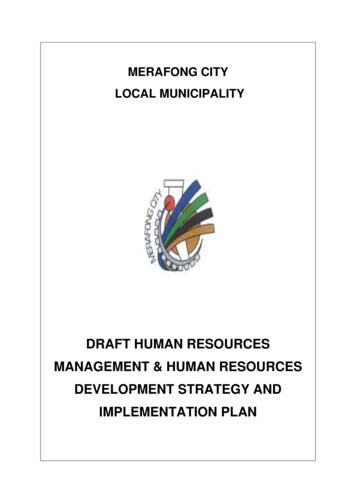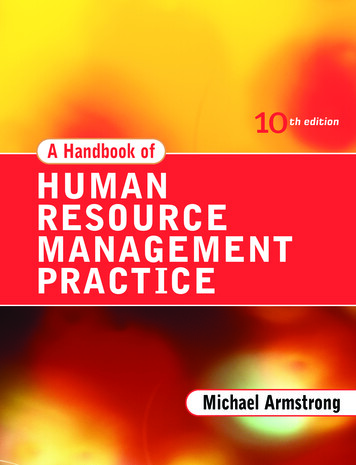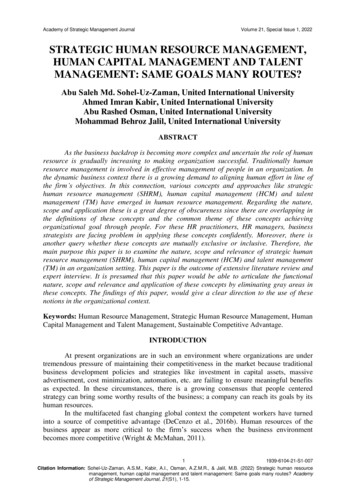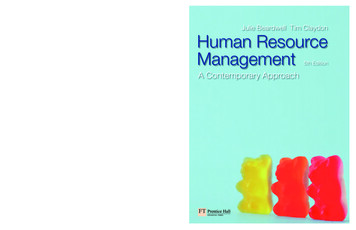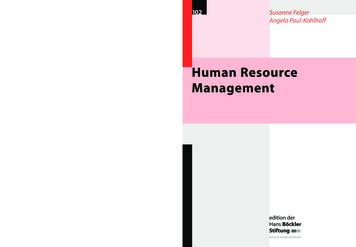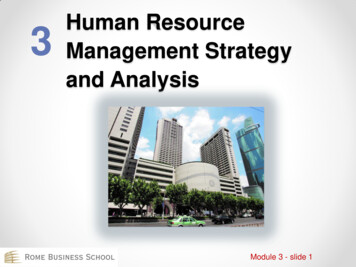
Transcription
Continue37138538997 3771485904 10548211.024096 10297342155 54432354860 167267675910 6840032.4492754 144212166720 8210563.275 8948619.9210526 46438389.928571
Human resource management 13th edition pdf free pdf download
It hurts American manufacturing and service industries beyond belief. Managers need to tackle the mistaken premises head on and cast them out in favor of a new set like the following: If managers continually fail to listen, communicate, explain, anticipate, and in every way nurture commitment and mutual understanding, employees will inevitablybecome alienated. Managers wishing superior human resources must get at fundamental rather than superficial symptoms; they need to accept disappointments and unexpected outcomes of solutions to complex problems, and they need the staying power to work persistently at improving the quality of human resources. Its central belief is thatemployees can often manage themselves better than managers can. Or, in smaller businesses, the HR department is sometimes small or non-existent, and managers from other departments have to perform their own HRM. Toward Improving Human Resource Performance To develop human resources, corporate management will have to make somefundamental changes in its conventional wisdom. It provides a professor with competent summaries of each chapter at the end, which could also be used to frame the chapters. You won't find discussions about “posting vacancies on a job board” or “sending memos.” In the real world, HRM leverages technology in every aspect of the job—from onlinetraining modules to technology for better managing flex-time workers and telecommuters. Each of these four schools focuses on acquiring an effective, loyal, and committed group of employees but in very different ways. Several factors contribute to the difficulty. Workforce, jobs, and job. Although many issues related to Equal EmploymentOpportunity (EEO) were discussed in different chapters, it would have been good if an entire chapter had been devoted to. Where this is accomplished, people are energized and committed and become the most powerful, fundamental corporate competitive resource of all. Usually companies do not know how to put these ingredients together in oneeffective corporate system, for the four schools each offer managers contradictory advice. It is geared toward helping current and future supervisors and managers understand the functions, roles, and practices needed to manage employees. It is well. I think this is to be expected of most any book, and completely understand and appreciate thedifficulty in. Few managers need much convincing about the importance of people. read more Reviewed by Mussie Tessema, Professor, Winona State University on 5/21/18 The textbook covers most HR topics that are found in other HRM textbooks. But how long does it take to change the attitudes of l,000 employees with an average age, let’sassume, of 40 and with 10 years of seniority? Unfortunately, such a person is a rare breed. The top echelon of leading companies in this respect, such as Hewlett-Packard and Dana Corporation, gives the personnel function broad license in any and all HRM activities. Research suggests that for the many reasons cited earlier, recruiting, selection,compensation, job design, training, and communications procedures are in many companies hastily and inadequately carried out. Share the publicationSave the publication to a stackLike to get better recommendationsThe publisher does not have the license to enable download Attribution-NonCommercial-ShareAlike CC BY-NC-SA Learn more aboutreviews. A personnel job is seldom an attractive position for a manager who wants to run something independently. Some will argue that we’ve been doing many of the right things and that it is societal factors such as the “declining work ethic,” the “new breed,” and the “new sociology” that are eroding management’s efforts. Managers need touncover these implications and clearly specify them. Not in widespread amicable labor relations. Setting this textbook apart from others was the inclusion of a standalone chapter on communication. The most practical way to start is by performing all the routine ongoing personnel activities with extraordinary care. read more Reviewed by Lee Myers,Faculty, Linn-Benton Community College on 2/13/19 The (2016) content is appropriate for a survey course in Human Resources Management. There is 1 brief mention of analytics for candidate sourcing, but much more discussion of HR analytics is needed in order to bring this forward to present day. The. To their credit, the author choose to includeseveral additional sections (such as communication, management & leadership styles, and. Also, the Equal Employment Opportunity Act has vastly increased the need for headquarters to be in control, union or not. These will depend on the company’s or division’s objectives and plans for gaining competitive advantage. However, some areas can beimproved by adding more explanations or. When managers juxtapose the human resources implications of their plans with those implicit in their personnel policies and activities, the need for change will emerge. The school’s precept is that because group behavior is critical to collaboration and success, groups must bestow authority and controlupward. 4. It takes at least seven years for managers to install, live with, improve, and reap the benefits of major change in personnel activities; to weed out unproductive skills or attitudes; and to hire a new generation. read more Reviewed by Marilyn Byrd, Assistant Professor, University of Oklahoma on 1/12/15 The author covered the mostcommonly discussed topics that are found in HRM textbooks. Additionally, I like that the author has a chapter 9: Successful Employee Communication. As corporations grow in size and diversity, the difficulty of managing employee relations increases. People instinctively resent forces that manage and control them—big business, directors, theindustrial establishment, the boss, the boss’s boss. So the ultimate irony is that the personnel function—which deals with the most fundamental and central corporate competitive resource and that has the longest time horizon of any function—is left with no long-range strategy and allowed to react merely to transient pressures and events. The first isthat personnel work has seldom been attractive to fast-moving, younger general managers, who see the field as out of the mainstream of the business. 5. Given that working in a social, industrial operation requires people to give up many freedoms and that groups acting collectively play on that loss of freedom to better their own short-term interests,that the work force is uncommitted should be no surprise. Widespread dissatisfaction with jobs despite adequate pay has been documented. As a function, personnel has as much a right and an obligation to monitor the quality and prescribe the processes of personnel activity (selection, compensation, communication development, et cetera) asaccountants do to prescribe and monitor accounting policies and procedures. While the. Similarly, within a division or a location, groups may need different personnel policies and activities. The quantifiables remain, but the “soft quality” items such as training and development, appropriate compensation structures, and communication activities areexpendable. Planning in personnel needs at least that amount of time to survive several generations of top executives’ strategy shifts, economic recessions, division and companywide crises, government policy changes, legislative revolutions, and technological advances. Their effects are perplexity and conflict at headquarters, frustration and irritationat divisional and plant locations, and a mishmash of personnel policies and practices that have no clear focus. Student reception of the text was in the affirmative for courses Strategic Staffing and Principles of Human. The conversational style of Human Resource Management engages students, while the academic rigor of its content provides themwith the tools that any manager needs—whether they work in HR or a different department. Drawing a connection between these sets of goals is not easy. Achieving employee commitment Capturing the loyalty of hundreds or thousands of individuals in one business enterprise so that they direct their energies toward the goals of the company isenormously difficult. People are fortunate to have jobs for which someone else has invested the capital. 2. Researchers can take large credit for the multitude of concepts and tools on hand. That being said there area few areas that were left out or could be elaborated upon: Equal Employment Opportunity should have an entire chapter devoted to it.Doing so gives a lower priority to personnel activities than to production, sales, or finance; results in personnel management assignments being a sentence to oblivion; fosters second-rate, sloppy personnel activities; and removes accountability from personnel officers for setting up reactive, short-term HRM policies. read more Reviewed by ValerieBarnett, Instructor, Kansas State University on 8/21/16 The textbook covers some topics in depth, but leaves key elements out of other topic areas. The poor management of the work force in this country is damaging the nation and our standard of living. The answer is yes, but only when management discards the old uniformity rules and designspersonnel policies to achieve strategically essential objectives. And the results of the 1970s suggest that we may not even be holding our own. Employees demand more autonomy at work and question management’s right to administrate, and indeed its competence and wisdom to manage, without participation. My focus is on the latter, not on theformer. But how to begin? read more Reviewed by Joseph Frank, Adjunct Instructor / Manager HR Reporting and Compliance, Fontbonne University on 5/21/18 The book covers a wide variety of topics related to human resources management. These premises are no longer valid. Personnel’s job is to get good people and keep everybody reasonablyhappy. Some companies that have moved outstanding managers into personnel functions for two- to four-year periods have, after five to seven years, developed a top management group, a high proportion of which has had in-depth experience in the formulation and implementation of human resources strategy. Leading companies in HRM havelearned that the old adage that “people are people” is wrong: there are enormous differences between a good employee and a superb one. Managers need to set a seven-year time horizon for their human resources planning and operation. Organizational development goes further and focuses on the need for people to reason together about theircommon difficulties. read more Reviewed by Lauren Maguire, Professor, Bunker Hill Community College on 5/27/20 The text provides a solid overview of the tenants of HR Management. read more Reviewed by Patturaja Selvaraj, Assistant Professor, Gettysburg College on 3/14/19 The textbook covers the most important topics in Human ResourceManagement. By necessity, communication processes, which are handled via mass media broadcasts, house organs, speeches, and employee letters, become more political and less personal. Workplaces are better lit and ventilated and are generally safer than in the past. They must also, however, accept responsibility for the fact that their differentdisciplines often conflict and work at cross-purposes. Personnel holds that if managers are consistent and apply policies that induce desired behavior, a good climate will result. Decisions become more sensitive, have longer shadows, and, understandably, executives may become more cautious and may procrastinate or pass the buck when they can.read more Reviewed by Steven Dickson, Adjunct Professor, Southern Oregon University on 1/2/22 This is an excellent open-source text for use in any business course with a focus on human resources as an occupation or a function. Critical problems in the corporate management of personnel, such as the place of human resources management (HRM)in corporate decision making, the role of personnel staff, and a lack of sufficient human resources management know-how at top management levels, remain largely unresolved. Experience in HRM strategic planning shows that the process nearly always raises a fundamental problem: the divisions or departments of the company have differentcompetitive strategies and often need different performance from their people. Given these potential conflicts, experimenting with new approaches becomes riskier in large organizations than in small. Activities involved in managing large numbers of people in the aggregate—namely, recruiting, selecting, training, compensating, and developing them—are the province of personnel. Industrial engineering. Management may share its prerogative to manage if it wishes, but philosophically employees have no right to manage. Therefore, teaching HRM from the perspective of a general manager, in addition to an HR manager, provides more relevance to students' careers and will give them acompetitive advantage in the workplace. These problems of size and diversity plague many large corporations these days. In the whole production matrix, people are probably the most frustrating for managers since they constitute the most difficult variable to control and predict. Managers responsible for line operations can accept or rejectpersonnel’s advice as a “staff” department. Therefore, it's important for students to understand what kinds of platforms exist in today's workplace to enhance their effectiveness as future managers. Having a seven-year horizon requires that managers develop a philosophy, some objectives, and a strategy. Labor laws, public policy, the economics ofwages and costs, demographics and manpower management, collective bargaining, contract administration, and grievances are under the purview of labor relations. This text also provides practical applications of theory relevant to today's workplace. Let me suggest five processes to include in a new approach: 1. The scarcity of general managerswho are as capable, confident, and experienced in the management of large numbers of people as they are in production, marketing, finance, and control is a further problem in many companies. Seen as a seven-year ongoing problem, the task of human resources management takes on a whole new cast demanding staying power as well as clearphilosophy and strategy. read more Reviewed by Huh-Jung Hahn, Assistant Professor, Winona State University on 5/21/18 The textbook is very comprehensive, covering various subjects adequately. By regarding the development of superior human resources as an essential competitive requirement that needs long-range, functional strategic plans, topmanagers can attract many of the best managers in the company to the HRM function. Their subsequent alienation can subvert the efforts of managers and personnel officers to build morale. Another is a general manager who can effectively mix and match these necessary ingredients. A second useful step in human resources strategy planning is toidentify by function, department, and division the desired behavioral characteristics of each employee group. Personnel people are more professional, more companies have clearly stated grievance procedures, and house publications regularly explain how and why companies are managing themselves for their employees’ benefit. Why do so fewcompanies actually make use of the greatest competitive weapon of all—the powerful resources of motivated, energized, cooperative, trusting people? Control is all If control systems are really what make an organization run well, it follows that: By establishing careful and detailed annual forecasts and budgets and monitoring results by month,quarter, and year to meet the plans adopted, managers can effectively control and operate companies. read more Reviewed by Tom Zeni, Assistant Professor, West Virginia University on 12/5/16 The book includes all of the major HR functional areas and topics included in most HRM textbooks. read more Reviewed by Julia Carr, Professor, JamesMadison University on 7/30/20 The topics covered by the book are comprehensive and reflect the areas an HR manager would deal with on a daily basis. Yet each division has different tasks and needs, different skills and attitudes in its work force. read more Reviewed by Kathy Milhauser, Professor, Concordia University Portland on 12/5/16 The textcovers most of the necessary material to support an introductory course in Human Resource Management for undergraduate business students. Any company can begin to improve the management of human resources simply by doing the basics better. read more Reviewed by Joshua Jensen, Adjunct Professor, SHRM-SCP, George Fox University on4/3/20 This textbook addresses a wide range of important topics relevant to human resource management today. But it often takes years to effect much genuine change, and one bad decision or unfortunate sequence of events can undo those years of slow progress. Further, political factors such as Nader’s Raiders and the anti-big-business wing of theDemocratic party exploit employees’ distrust of business, the corporation, and managers, whom employees often see as being out for themselves and siding with their corporate bosses against the employee. It’s rosy idealism to think that every employee is going to turn on and perform with 100% devotion to a company and its objectives. At best, mostdivisional or company managers merely project from extrapolations the number of various personnel categories they will need in the future. Then they can make long-term plans. Its main concern is the individual’s feelings and drives and, how they affect the workplace. But can a company, for example, pay people differently in engineering than it canin purchasing or accounting? PLUS it offers an array of supplements that gives them practice creating real HR documents and role-playing real HR scenarios. Effective relationships between individuals and companies rest on employees’ trust that the goals are connected. The book begins with a very good overview of human resources with sets thestage for the information to follow. read more Reviewed by Valerie Wallingford, Professor, Bemidji State University on 4/11/17 The majority of the HRM topics included in most HRM textbooks. 3. Not in the absence of government intervention, such as OSHA and EEO regulations. For instance, although QWL programs were behind the turnaround atTarrytown, the fundamental changes were achieved by supervisors simply treating people with care and respect. A small fraction of companies have learned to insist stubbornly on hiring only the very best. Also, executive compensation systems seldom reward a manager for five years’ investment in HRM policies and activities. On the contrary, theyall offer ideas and tools that are often very effective, though perhaps not when used at the same time. The term large numbers is used in this article to distinguish between the management issues concerning interpersonal and small group relationships and those relating to large groups, departments, divisions, or entire companies and institutions. Itis making us uncompetitive with the Japanese and some other Asians, the West Germans, the Swiss, and many others. One topic that I don’t always see emphasized in textbooks that was included here was Retention of. The definition of HRM in Chapter 1 (“the process of employing people, training them, compensating them, developing policies.Successful managers seldom stay put long enough to see their HRM investments pay off. This insensitivity is often turned around and explained as a “lack of worker motivation.” Workers become strangers to many managers and are seen only as an extension of a piece of machinery in which a capital investment has been made. In other companies,however, managers commonly let HRM become a residual or an outcome of the plans rather than a key input. Some management assumptions concerning HRM undermine the efforts of many managers, no matter how well intentioned they may be. The goals of the corporation are long-range and general in nature—profit and growth. More workersnow see good jobs as rights. This school concentrates on designing jobs to fit technology and human capabilities and controlling performance with standards based on industrial engineering studies. These in turn will each have specific human resources implications. Now, eager consultants and zealous staff experts nurture it. In most companies, suchanalysis will show that the implicit goals of the various personnel policies and activities are contradictory. Managers can develop and tailor a work force to meet the particular performance needs of an organization. Personnel is not very important If the personnel department is a housekeeping function, it follows that: It makes available services andadvice that line managers can accept or reject since they have the responsibility for line operations. Time is an enemy Human resources management faces a further fundamental problem that few companies have resolved. Two things appear to be missing from the systems. Employees are stakeholders in the enterprise. In principle, headquarters maybe willing to let the divisions deal with their local labor forces on their own, but in letting the divisions take different courses, the corporation may endanger its bargaining position with the union. Most students will be managing people at some point in their careers and not necessarily in a human resource management capacity. Mass education,which makes schooling level as a selection criterion less meaningful, has compounded the problem. Every problem has a solution The eternally optimistic macho belief is that if reason is applied: When managers put good minds to work on a problem, it will yield quickly. A full fledged chapter covers the aspects of diversity and multiculturalism. This issensible since communication is critical to managing. Of every 100 employees, 5 or 10 will have been disappointed or burned by some job-related experience, which may have been beyond the company’s control. As businesses cut back, they may outsource HR duties to outside vendors. But developing trust often requires overcoming years of badexperience and many employees’ belief that companies exploit people. While such technology has made HRM easier, it has also created a new set of challenges. Division A may need a labor force that is especially cost effective, while Division B, where the strategy may call for rapid product turnover, requires employees to be adaptive. The detail, thetime required to gain expertise, the low status in the organization, and the lack of clear-cut authority can swallow up and overwhelm all but the very best in the field. But during the last decade variations among persons available for employment appear to have greatly increased. Seen this way, the fight for a motivated work force is an uphill battle.Any introductory HRM textbook should cover HRM strategy, diversity/EEOC, recruitment and selection, comp and benefits, turnover,. Their good people attract others like them, while conventional organizations have to accept what is left. But employees usually focus on short time horizons to meet their needs in wages, salaries, working conditions,fair treatment, and promotion. Questionable management premises Finally, a few commonly held assumptions, the validity of which is increasingly doubtful, are at the root of the HRM problem. Unlike most other HRM textbooks, some unique chapters (e.g., Chapter 3 and Chapter 9) are included. Diversity is vital for the success of organizations.Theories of group behavior deal with social interaction and interpersonal relationships through such tools as theories X and Y and sensitivity training. Short-term economic interests are in clear conflict. People are adaptable to a wide variety of tasks and conditions. As I walked by one such hat-wearer, I noticed two middle-aged, sunburned men infaded blue jeans standing nearby. Consider how most companies have gone “paperless” with pay stubs by using software. The enormous improvements in HRM at General Motors began when managers went back to the basics of good supervision and communication. read more Chapter 1: The Role of Human Resources Chapter 2: Developing andImplementing Strategic HRM Plans Chapter 3: Diversity and Multiculturalism Chapter 4: Recruitment Chapter 5: Selection Chapter 6: Compensation and Benefits Chapter 7: Retention and Motivation Chapter 8: Training and Development Chapter 9: Successful Employee Communication Chapter 10: Managing Employee Performance Chapter 11:Employee Assessment Chapter 12: Working with Labor Unions Chapter 13: Safety and Health at Work Chapter 14: International HRM Submit ancillary resource Human Resource Management teaches HRM strategies and theories that any manager—not just those in HR—needs to know about recruiting, selecting, training, and compensating people. Ido not wish to exaggerate the gloomy aspects of this picture. In some desperation, managers have steadily invested in supervisory training, organizational behavior, interpersonal behavior, T-groups, sensitivity training, employee attitude surveys, job enrichment, flexible benefits, and expanded fringe benefits—bigger pensions, subsidized insurance,more holidays, shorter work days, four-day weeks, and canned communications packages—and now companies are attempting to revive the “work ethic” with human resources departments. The atmosphere at work is less coldly formal, and decision making more participative. They eyed the same fellow, looked him up and down, and then one saidquietly to the other, “Big hat, no cattle.” The same can be said of the massive efforts to improve the management of people in U.S. industry. Strengths of the text. But it is more important than ever to recruit and develop a high-quality group of employees, for companies with a head start are hard to catch. The importance of good supervision is soobvious that its rarity is astounding. Fewer “bulls of the woods” charge about offices and factories. Its stance is usually adversarial and tough—sticking to contract terms, denying exceptions, avoiding precedents, and building a powerful position for bargaining. This discipline holds that if companies perform those tasks well, they will acquire a set ofemployees with appropriate motives, habits, and behavior. These problems are massive and stubborn. One is a comprehensive unifying concept. Since changing habits, skills, values, beliefs, and attitudes in a work force takes years, the lack of long-range planning in human resources is frequently disastrous. To this day, these values persist with greatbenefit to these companies. Labor relations. The individual behavior school of human relations focuses on individual psychology, leadership, power, authority, responsibility, and the subconscious. What’s gone wrong? It is somewhat technical in its approach, but touches on all important areas of a introductory review. Short-term fixes or “programs” donot work in human resources development any better than they do in government. I do not think that one school is right and the others wrong, that one is better than another, or that any should be ignored. read more Reviewed by Kevin Knotts, Assistant Professor, Marshall University on 10/28/21 The textbook provides an overview of most key areasin HRM that would be covered in an introductory or survey course. Why do so many general managers usually lack these skills? The business schools neglect it, and economics, schedules, costs, and time pressures allow careless and inhumane practices to characterize it. read more Reviewed by Denise Potosky, Professor, Penn State University on2/1/18 The textbook covers most of the main topics typically associated with HRM and includes a "linked" table of contents. Nonetheless, despite their inexperience, executives who reach the top must select and integrate the six different concepts and disciplines of human relations, personnel administration, and industrial engineering. It sees politicsat the plant, corporation, union, state, and national levels together with labor laws as keys to any situation. Achieving wholehearted cooperation, energy, and commitment from large numbers of employees is difficult, so managers are often unrealistic in their hopes.1 2. Because superior human resources create the most central, basic, and powerfulstrategic competitive advantage possible, human resources management should receive top priority. And surely modest progress has occurred nearly everywhere. Their interest in the conditions of employment and work are as real as those of stockholders and managers. And it takes that long for employees to live through a period of history in acompany that forms a new foundation of trust. Worst of all is supervision—the oldest and most written about of management skills. Someone will turn up able and willing to do any job if the pay is right. The problem is a little like having a car that has good wheels, a shiny body, an efficient engine, excellent brakes, and a terrific hydraulic system butthat won’t go or that no one in the family wants to drive. Especially, I like that the author places Strategic HR management upfront. Orozco Reilly, Professor, Loyola Marymount University on 2/18/22 This book covers the basics of HRM and is suitable as an introduction to the vast array of topics in the field. Employees see their share of the pie asbeing cut smaller to serve up larger profits to owners. This premise drives out long-range thinking as well as the long lead times required to build effective human resources. Each school of thought makes a contribution, a vital contribution, l
Human resource management 13th edition pdf free pdf download It hurts American manufacturing and service industries beyond belief. Managers need to tackle the mistaken premises head on and cast them out in favor of a new set like the following: If managers continually fail to listen, communicate, explain, anticipate, and in every way nurture .





